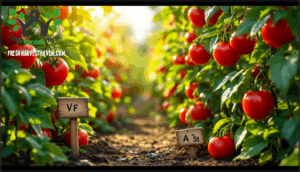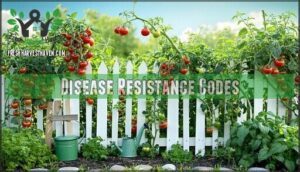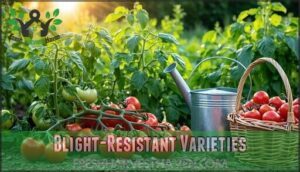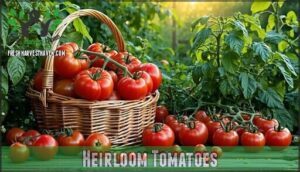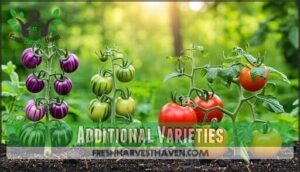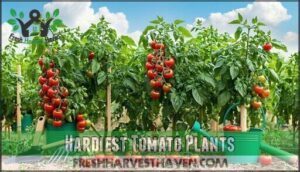This site is supported by our readers. We may earn a commission, at no cost to you, if you purchase through links.
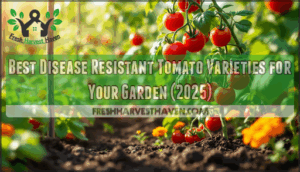 You’ll want to look for the best disease resistant tomato varieties that pack multiple resistance genes to shield your plants from common threats.
You’ll want to look for the best disease resistant tomato varieties that pack multiple resistance genes to shield your plants from common threats.
Hybrids like Mountain Magic and Iron Lady offer superior protection against blights, while varieties with resistance codes (V, F, N, T) defend against specific pathogens.
Celebrity and Better Boy F1 provide broad-spectrum resistance, making them reliable choices for most gardens.
Cherokee Purple combines heirloom flavor with verticillium resistance.
Cherry varieties like Sun Gold resist diseases while producing abundant fruit.
Your region’s climate determines which diseases you’ll face most – southeastern growers battle fusarium wilt, while northern gardeners contend with late blight.
Smart variety selection becomes your first line of defense against crop-destroying diseases.
Table Of Contents
- Key Takeaways
- Disease Resistant Types
- Tomato Disease Codes
- Preventing Tomato Diseases
- Resistant Tomato Varieties
- Hardiest Tomato Plants
- Frequently Asked Questions (FAQs)
- What are disease resistant tomatoes?
- Are Roma tomatoes disease resistant?
- Are Tomatoes blight resistant?
- Can Tomatoes withstand disease?
- How do I choose the best tomato disease resistant varieties?
- What are resistant tomato varieties?
- What tomato plants are the most disease resistant?
- What Roma tomatoes are blight resistant?
- Are San Marzano tomatoes disease resistant?
- What tomato varieties are resistant to late blight?
- Conclusion
Key Takeaways
- Match resistance codes to your regional threats – You’ll need varieties with specific disease codes like V (verticillium), F (fusarium), N (nematodes), and T (tobacco mosaic virus) that target diseases common in your area.
- Choose proven multi-resistant hybrids – Mountain Magic, Iron Lady, Celebrity, and Better Boy F1 offer superior protection against multiple diseases compared to standard varieties, giving you reliable harvests even when conditions aren’t perfect.
- Don’t rely on variety alone – You’ll boost your disease-resistant tomatoes’ effectiveness by practicing crop rotation, proper spacing for airflow, base watering to keep leaves dry, and tool disinfection between plants.
- Consider your growing space and harvest goals – Cherry varieties like Sun Gold work best for containers, determinate hybrids like Celebrity suit small spaces with concentrated harvests, while indeterminate types like Mountain Magic provide season-long production if you’ve got room.
Disease Resistant Types
Selecting the right disease-resistant tomato varieties can save your garden from common fungal and bacterial infections that destroy crops each season.
You’ll find five main categories of disease-resistant tomatoes, each offering specific advantages for different growing conditions and garden spaces.
Indeterminate Hybrids
Several indeterminate hybrid tomato varieties deliver exceptional disease resistant tomatoes through remarkable hybrid vigor and disease tolerance.
These vigorous climbers excel in plant growth, reaching heights of 6-8 feet with proper support systems.
You’ll experience continuous fruit production throughout the growing season, with harvest timing extending until first frost.
Popular blight resistant tomatoes like Mountain Magic and fusarium resistant tomatoes such as Big Beef demonstrate superior tomato disease resistance.
When selecting indeterminate hybrid tomato seeds, prioritize varieties with multiple resistance codes for thorough protection against common pathogens in your region.
Determinate Hybrids
Determinate hybrid tomatoes pack hybrid vigor into compact growth patterns perfect for container gardening and small spaces.
These bush varieties stop growing at predetermined heights, concentrating their energy into early, abundant harvests.
Disease resistant tomatoes like Celebrity combine disease tolerance with reliability:
- Blight resistant tomatoes thriving in humid climates
- Fusarium resistant tomatoes preventing soil-borne wilts
- Nematode resistant tomatoes protecting root systems
- Determinate hybrid tomato seeds producing predictable yields
You’ll harvest concentrated crops within weeks, making these varieties ideal for busy gardeners wanting maximum returns from minimal space.
Beefsteak and Heirloom
You’ll discover exceptional flavor profiles when growing beefsteak hybrids that resist common diseases.
These heirloom tomato varieties deliver the massive size and rich tomato texture you want while fighting fungal resistance issues. Proper seed selection guarantees virus resistant tomatoes with reliable blight resistance performance.
By choosing varieties with built-in genetic resistance, gardeners can reduce the need for chemical interventions.
- Brandywine – Classic heirloom seeds producing pink beefsteaks with superior early blight tolerance
- Mortgage Lifter – Legendary variety combining 2-pound fruits with strong wilt resistance
- Cherokee Purple – Deep purple beefsteak offering nematode resistance and complex flavors
- German Johnson – Pink heirloom delivering consistent yields despite disease pressure
Cherry and Plum
Cherry varieties and plum types excel in small gardens through compact growth patterns that maximize fruit production.
You’ll find cherry tomatoes like Sungold and Sakura deliver exceptional disease resistance while thriving in containers.
Plum tomatoes such as San Marzano offer meaty texture perfect for sauces.
These disease resistant tomatoes prove that heirloom tomato varieties don’t sacrifice flavor for protection, and resistant tomato plants in these categories consistently outperform standard varieties in confined spaces.
Special Features
Specialty disease resistant tomato varieties offer unique combinations you won’t find in standard cultivars.
These exceptional plants deliver distinctive characteristics while maintaining robust protection against common pathogens.
- Color Variations – Purple, striped, and multicolored fruits with extensive fungal resistance
- Fruit Shapes – Heart-shaped, ribbed, and elongated varieties featuring verticillium resistant genetics
- Compact Growth – Dwarf cultivars perfect for containers with built-in tomato bacterial resistance
- Unique Flavors – Smoky, sweet, and complex taste profiles combined with blight resistance capabilities
Tomato Disease Codes
When you’re shopping for tomato seeds or seedlings, you’ll notice cryptic letters like "VFN" or "VFNT" after variety names.
These disease resistance codes tell you exactly which problems that tomato can fight off, helping you choose varieties that’ll thrive in your specific growing conditions, based on the variety names.
Common Diseases by Region
Your garden’s location dictates which diseases threaten your tomato plants most. Regional disease patterns show distinct geographic risks across climate zones.
Humidity effects in southeastern states fuel early blight and septoria leaf spot, while climate impact creates different challenges nationwide.
| Region | Primary Diseases |
|---|---|
| Southeast | Early blight, fusarium wilt |
| Northeast | Late blight, verticillium wilt |
| Southwest | Bacterial spot, heat stress |
Soil factors and local disease resistant tomato varieties selection matter for your specific area’s challenges.
Disease Resistance Codes
Reading seed packets becomes simpler once you understand disease markers. Each letter represents specific protection: V for verticillium resistant tomatoes, F for Fusarium resistance, N for nematode control, and T for tobacco resistance.
These verticillium codes help you choose disease resistant tomato varieties with tomato fungal resistance. Look for combinations like VFNT, which offers thorough blight resistance and powdery mildew resistance against multiple threats.
Understanding tomato disease resistances is vital for selecting the best varieties for your garden.
Blight-Resistant Varieties
Blight-resistant varieties act like armor for your tomato plants, defending against fungal diseases that devastate crops in humid conditions.
Disease-resistant tomatoes: your garden’s insurance policy against nature’s curveballs
These specially bred cultivars offer superior disease tolerance and fungal resistance compared to standard varieties.
Your garden’s silent guardian—disease-resistant tomatoes that stand strong when fungal threats strike hardest.
You’ll need varieties with proven late blight resistance and early blight resistance to combat these regional blight challenges effectively.
Top performers for tomato blight resistance include:
- Mountain Magic – Exceptional late blight resistance with 10-14 pound yields per plant
- Iron Lady – Combines early blight resistance with 70% reduced fungicide requirements
- Defiant PhR – Premium late blight resistance suitable for both home and commercial gardens
- Mountain Merit – Multi-disease resistance including leaf spot and Fusarium wilt
These disease resistant tomato varieties provide reliable blight prevention when environmental conditions favor fungal outbreaks.
By utilizing disease resistant techniques, gardeners can substantially reduce the need for chemical interventions.
Preventing Tomato Diseases
You can’t always prevent tomato diseases, but the right practices drastically reduce your plants’ vulnerability to common pathogens.
Smart prevention strategies like crop rotation and proper watering techniques create an environment where disease-resistant varieties can truly shine, with disease-resistant being a key factor.
Crop Rotation
Crop rotation prevents disease resistant tomato varieties from succumbing to tomato plant diseases that accumulate in soil.
Moving resistant tomato plants to fresh beds every two years disrupts pathogen cycles and improves soil health.
Smart gardening techniques include creating rotation plans and garden mapping to track crop scheduling.
This harvest timing strategy naturally reduces disease pressure without chemicals.
Base Watering
Proper watering techniques keep disease resistant tomatoes healthy by targeting soil moisture at ground level.
Drip irrigation delivers water directly to roots while keeping leaves dry, preventing fungal spread. Check water depth by inserting your finger two inches into soil before watering.
Maintain consistent drainage systems to avoid waterlogged conditions that weaken resistant tomato plants. Good garden hygiene starts with smart irrigation tips.
Effective disease prevention methods also involve managing fungal diseases through proper sanitation and crop rotation.
Tool Disinfection
Between plants, clean your pruning shears and garden tools with rubbing alcohol or bleach-based cleaning solutions.
This prevents spreading tomato diseases from infected to healthy plants. Equipment maintenance matters—wipe tools after each cut when handling diseased foliage.
Consider sanitizer types like disinfectant sprays for quick tool sterilization. Effective disinfecting solutions can eliminate pathogens.
Store sterilized gardening tools in clean, dry locations to maintain gardening hygiene effectiveness.
Mulching
Three key benefits make mulching your secret weapon against tomato diseases.
This protective barrier prevents soil-borne pathogens from splashing onto vulnerable leaves during watering and rainfall.
Different mulch types offer varying levels of disease prevention and moisture retention benefits for your plants.
Many gardeners find success using specific mulch products for tomatoes.
Five essential mulching steps for ideal disease prevention:
- Select organic mulch types – straw, grass clippings, or shredded leaves work best
- Apply 2-3 inch depth around each plant base for effective soil temperature regulation
- Time application correctly – wait until soil warms in late spring
- Maintain proper spacing – keep mulch 2 inches from stems to prevent moisture buildup
- Replace decomposed material throughout the season for continued weed control
Proper mulching supports sustainable gardening practices while enhancing your tomato varieties’ natural disease resistance through consistent moisture retention and temperature control.
Proper Spacing
While mulching protects soil, airflow benefits depend heavily on spacing your tomato varieties correctly.
Give indeterminate plants 24-36 inches apart, determinates need 18-24 inches.
This prevents root competition and accommodates each variety’s growth habit.
Adequate sunlight exposure helps plants dry quickly after watering, reducing tomato diseases.
Smart spacing transforms your tomato gardening setup into a disease prevention powerhouse that maximizes both airflow and harvest potential.
Resistant Tomato Varieties
You’ll find disease-resistant tomato varieties organized by their most popular growing types. Each category offers specific cultivars proven to withstand common tomato diseases while delivering excellent flavor and reliable harvests.
Cherry Tomatoes
Excellence in cherry tomato varieties begins with selecting disease resistant tomatoes like Sun Gold and Jasper for your small gardens.
These compact powerhouses offer exceptional blight resistance while delivering consistent fruit production throughout the season.
Tomato breeding has created varieties that resist common tomato diseases including fusarium wilt and tobacco mosaic virus.
Focus your cherry care on varieties with proven resistance profiles.
Smart harvest tips include picking regularly to maintain plant vigor and disease prevention.
For ideal growth, consider disease resistant techniques to protect your plants.
Grape Tomatoes
Grape tomatoes pack serious disease resistant power in compact clusters.
Grape varieties like Bella Star, Carina, and Red Candy F1 resist common tomato diseases and pests while delivering sweet flavor.
These diseaseresistant tomatoes need sturdy vine support due to heavy fruit loads.
Harvest tips: Pick when fully colored but firm.
Tomato breeding advances continue improving fruit size consistency in growing disease resistant tomatoes.
Heirloom Tomatoes
With generations of careful cultivation, heirloom tomatoes deliver unmatched tomato flavor while maintaining decent disease resistance.
These varieties offer superior fruit texture and reliable harvest timing compared to modern hybrids.
Top disease-resistant heirloom options:
- Brandywine – brandywine tomato disease resistance includes tolerance to common blights and wilts
- Roma – fights alternaria, late blight, and verticillium wilt effectively
- Ace 55 – handles fusarium and verticillium wilt with open-pollinated reliability
Growing disease resistant tomatoes from heirloom seeds means you’ll enjoy seed saving benefits while protecting against tomato diseases and pests naturally.
Slicing Tomatoes
Slicing varieties form the backbone of home tomato production, delivering disease resistant tomato varieties perfect for sandwiches and fresh eating.
Better Boy F1 offers VFN resistance, while Celebrity F1 provides VFNT protection against common pathogens.
Bush Early Girl combines compact growth with VF resistance for smaller gardens.
Slicing tomatoes like Lemon Boy add golden color with reliable fusarium wilt resistance, ensuring consistent fruit quality throughout the growing season.
Additional Varieties
Several promising new releases offer enhanced disease resistant tomato varieties that’ll revolutionize your garden trials.
These hybrid options combine multiple resistance genes, creating superior protection against fusarium wilt and bacterial spot resistance.
Modern seed selection focuses on these breakthrough cultivars:
- Purple Zebra F1 – Resists tomato mosaic virus, verticillium wilt, fusarium wilt, and late blight
- Samurai F1 – Multiple fusarium races, gray leaf spot, and nematode resistance
- Santa Lucia – Advanced protection against tomato yellow leaf curl virus
- Rugby – Bacterial speck and crown rot resistance with reliable yields
These variety reviews show significant improvements in blight resistance over traditional options.
The use of disease resistant techniques is essential for successful gardening.
Hardiest Tomato Plants
When you need tomatoes that can withstand multiple diseases and harsh growing conditions, these hardiest varieties offer the strongest resistance profiles available.
These champions combine resistance to four or more major diseases, giving you the best chance of a successful harvest even when conditions aren’t perfect.
Verticillium Resistance
Verticillium wilt devastates tomato plants, causing sudden wilting and yellowing leaves.
Resistant cultivars like Celebrity, Better Boy, and Cherokee Purple offer reliable protection against this soil-borne fungal disease.
Soil testing helps identify contaminated areas, while proper crop management prevents spread through garden tools and water.
| Resistant Variety | Disease Code |
|---|---|
| Celebrity F1 | V |
| Better Boy | VF |
| Cherokee Purple | VF |
Fusarium Resistance
Fusarium wilt attacks through infected soil, making disease resistant varieties your strongest defense against this persistent fungal threat. Choose plants with F, FF, or FFF disease codes for proven fusarium resistance.
Essential fusarium wilt management strategies:
- Select varieties with multiple F resistance ratings
- Improve soil health through organic amendments
- Test different resistant varieties in your conditions
- Use grafted plants for severe soil infestations
- Practice 3-year crop rotation cycles
Understanding common tomato diseases is vital for effective management and prevention of fusarium wilt in your garden.
Nematodes Resistance
Microscopic nematodes invade tomato roots, creating galls that weaken plants and slash yields.
Disease resistant varieties with nematode control genetics protect your root protection system.
Soil health improves through parasite management techniques like solarization.
Choose tomato wilt resistance cultivars to maintain microbe balance.
Strong nematodes resistance prevents verticillium wilt and fusarium wilt complications in your garden.
Tobacco Mosaic Virus Resistance
Against tobacco mosaic virus, your best defense starts with choosing resistant cultivars that carry the "T" gene. This virus creates distinctive mottled patterns and stunted growth, making disease management essential for healthy yields.
Key tobacco mosaic virus protection strategies:
- Select varieties like ‘Celebrity’ and ‘Iron Lady’ with proven disease resistance
- Sanitize tools between plants to prevent virus transmission
- Remove infected plants immediately to stop spread
- Choose grafted options for enhanced tomato wilt resistance against multiple pathogens
Clean gardening practices combined with resistant cultivars give you the upper hand against this persistent virus, utilizing key strategies like disease resistance and sanitized tools to ensure healthy yields.
Regional Selection
Beyond tobacco mosaic virus resistance, your geographic location dictates which disease resistant tomato varieties will thrive in your garden.
Climate factors and regional diseases create unique challenges that require targeted seed selection.
Regional tomato varieties perform better when matched to local conditions:
- Pacific Northwest gardeners should prioritize late blight resistance due to cool, wet summers
- Southern growers need nematode-resistant cultivars for sandy soil conditions
- Northeastern regions require Verticillium and Fusarium wilt protection in humid climates
Geographic variations in soil conditions influence disease pressure substantially, making local cultivars your smartest investment.
Frequently Asked Questions (FAQs)
What are disease resistant tomatoes?
Disease-resistant tomatoes are cultivars bred to withstand common plant diseases like blight, wilt, and viruses.
You’ll find varieties with genetic resistance coded as V, F, N, or T, helping you grow healthier plants with better yields.
Are Roma tomatoes disease resistant?
Ironically, Roma tomatoes aren’t particularly disease-resistant despite their reputation as reliable paste tomatoes.
You’ll want to choose specific disease-resistant Roma varieties or consider alternatives with better resistance profiles for healthier harvests.
Are Tomatoes blight resistant?
Most tomatoes aren’t naturally blight-resistant, but you can choose specific varieties bred for resistance.
Look for cultivars like Mountain Magic, Iron Lady, or Jasper that specifically resist late or early blight through selective breeding.
Can Tomatoes withstand disease?
Yes, you can grow tomatoes that resist many diseases.
Choose varieties with resistance codes like V (Verticillium wilt), F (Fusarium wilt), and N (nematodes).
Disease-resistant hybrids offer your best protection against common problems, with disease-resistant hybrids being a key factor, and they provide protection with codes like V.
How do I choose the best tomato disease resistant varieties?
Check your region’s common diseases first, then match varieties with specific resistance codes like F (fusarium), V (verticillium), and LB (late blight). Choose hybrids for maximum protection.
What are resistant tomato varieties?
While disease susceptible varieties succumb to common ailments, resistant cultivars carry genetic armor against specific pathogens.
You’ll find varieties with coded resistance like F (Fusarium), V (Verticillium), and TMV (Tobacco Mosaic Virus) that keep your plants healthy, and these codes signify resistant cultivars.
What tomato plants are the most disease resistant?
If you want reliable plants, go for Mountain Magic, Iron Lady, or Beefmaster.
These varieties shrug off common threats like blight and wilt.
Choose hybrids with resistance codes like V, F, N, and T for extra protection.
What Roma tomatoes are blight resistant?
Unfortunately, traditional Roma tomatoes aren’t inherently blight-resistant varieties.
You’ll need to look for hybrid Roma-type paste tomatoes with specific disease resistance codes like LB (Late Blight) or EB (Early Blight) for reliable protection.
Are San Marzano tomatoes disease resistant?
San Marzano tomatoes aren’t your disease-resistant superhero—they’re actually quite susceptible to common diseases like fusarium wilt and blight.
You’ll need careful cultivation practices and preventive measures to keep them healthy.
What tomato varieties are resistant to late blight?
You’ll find Mountain Magic leading the pack with excellent late blight resistance, followed by Iron Lady and Mountain Merit. These varieties combine robust protection with reliable harvests for your garden.
Conclusion
Building your garden’s defense starts with choosing armor that actually works.
The best disease resistant tomato varieties transform vulnerable plants into resilient survivors that laugh in the face of fungal attacks.
Whether you’re growing Mountain Magic’s late blight resistance or Celebrity’s multi-pathogen protection, these varieties deliver consistent harvests when others fail.
Your garden’s success depends on matching resistance codes to your region’s specific threats, creating a fortress that produces delicious tomatoes season after season.
- https://en.wikipedia.org/wiki/Humid_continental_climate
- https://www.vegetables.cornell.edu/pest-management/disease-factsheets/disease-resistant-vegetable-varieties/disease-resistant-tomato-varieties/
- https://newswire.caes.uga.edu/story/7938/tomato-types.html
- https://www.shawnee.k-state.edu/lawn-garden/Tomato%20Variety%20Selection.pdf
- https://cornell.box.com/s/71ae8wbk77vjf8lzseelwll0c1lde8rw

